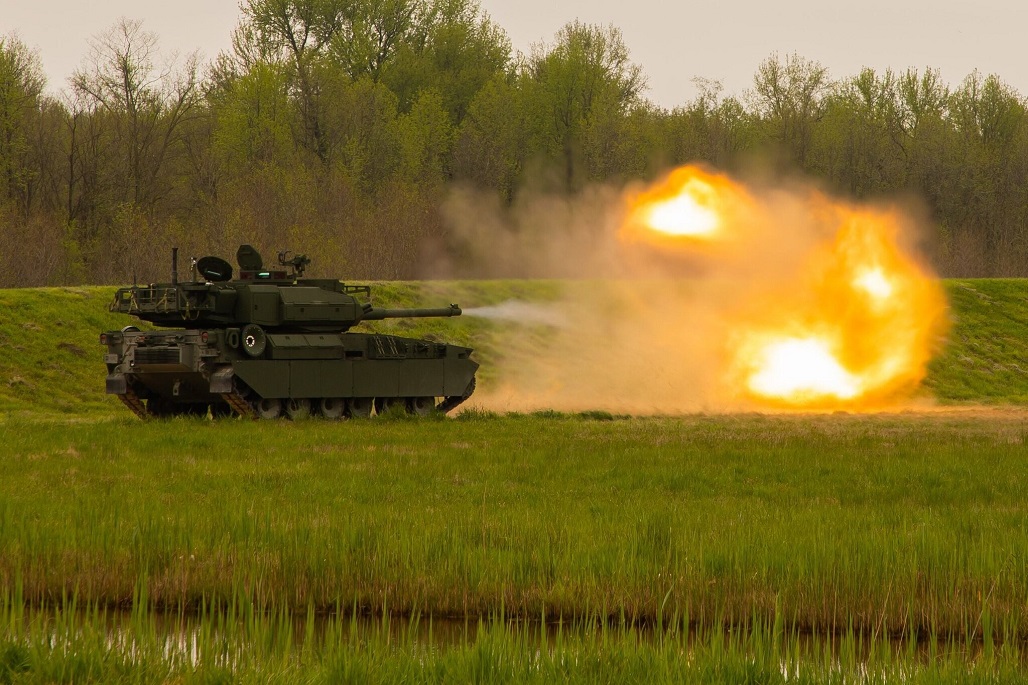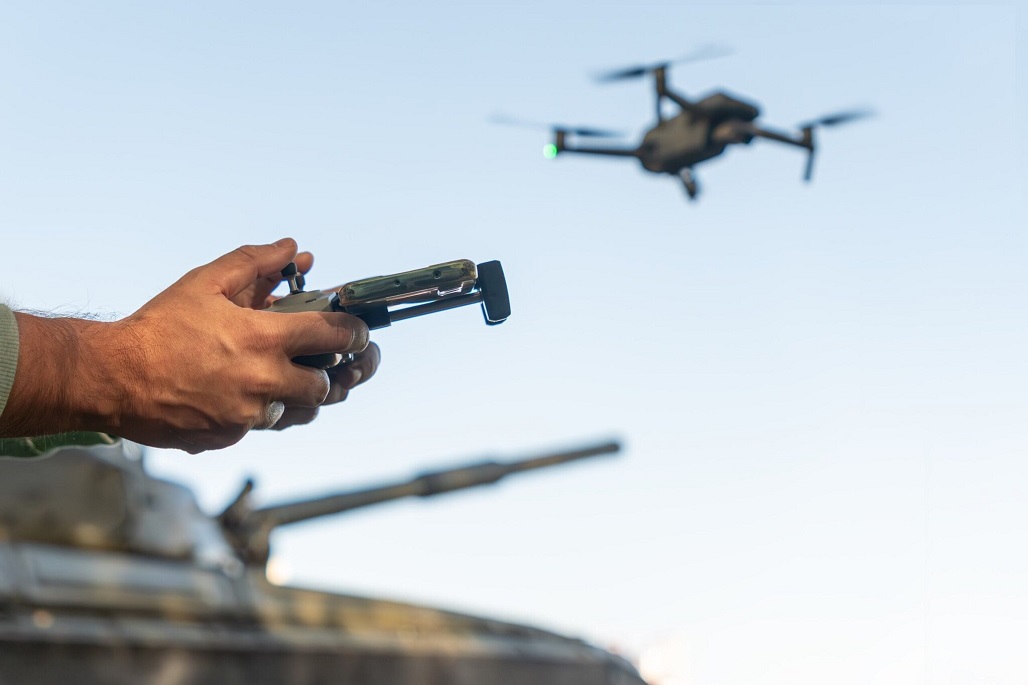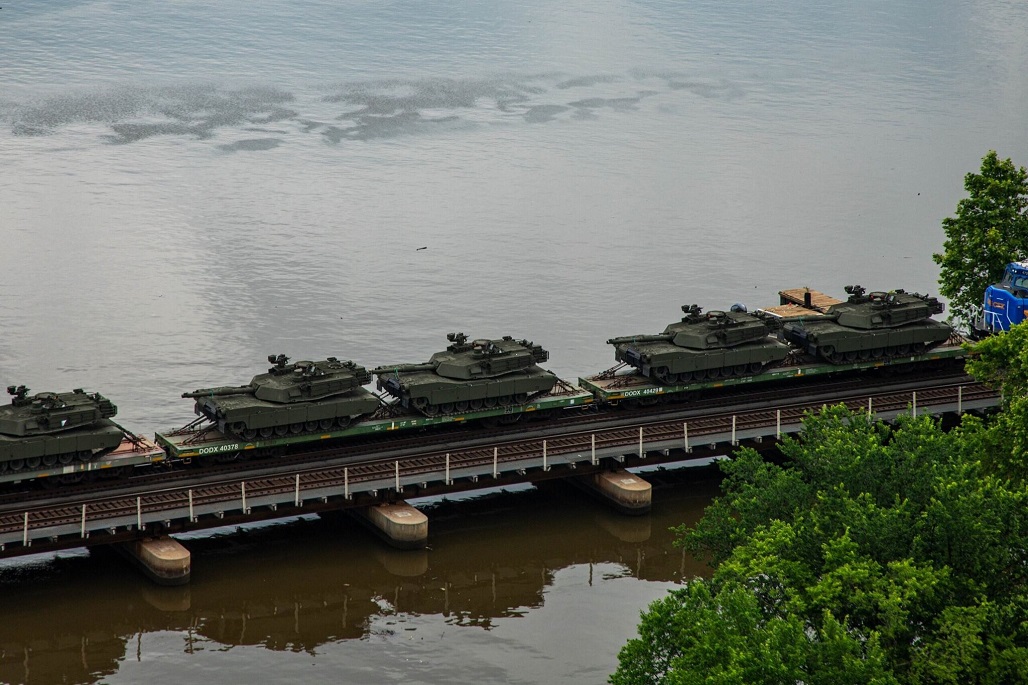| The Booker dilemma: inside US Army transformation
“布克”困境:美国陆军转型内幕 Date:2025-07-16 Source:globaldefencetechnology By: Jen Kirby Viewed: |
The decision to cancel the M10 Booker light tank is at the core of a reordering of US Army planning. Jen Kirby reports.
取消M10"布克"轻型坦克的决定是美国陆军重新规划的核心。詹·柯比报道。

A US Army M10 Booker light tank. Credit: U.S. Army / Cpl. Jonathon Downs
美国陆军M10布克轻型坦克。图片来源:美国陆军/乔纳森·唐斯下士
Officially, the M10 Booker is a ground combat vehicle. Unofficially, it’s a light tank. Whatever its designation, the United States Army created the M10 to provide mobile firepower to light infantry brigades.
官方定义中,M10布克是地面作战车辆。非官方定义中,它被归类为轻型坦克。无论其具体名称如何,美国陆军研发M10的初衷,是为了给轻步兵旅提供机动火力支援。
The force sought armoured equipment that was easy to airdrop and could manoeuvre swiftly across terrains, while also being sturdy enough to withstand an enemy assault and possessing enough firepower to do some damage back.
该力量寻求易于空投的装甲装备,可以在地形上迅速机动,同时足够坚固以抵御敌人的攻击,并拥有足够的火力进行反击。
But to meet all those requirements, the US Army got a bulkier vehicle than the more deployable, nimble one it initially envisioned. A tank – but not exactly a light one at around 40 tonnes. When the 101st Airborne Division received the first M10 Booker deliveries in 2024, it discovered eight of 11 bridges at Fort Campbell could not handle its weight.
但要满足所有这些要求,美军最终获得的坦克比最初设想的更易部署、更灵活的车型要大得多。这是一辆坦克——但严格来说并不算轻型,其重量约为40吨。当第101空降师在2024年接收首批M10布克坦克时,发现坎贝尔堡的11座桥梁中有8座无法承受其重量。
This helps explain why the US Army abruptly cancelled the M10 Booker in May 2025. “The Booker is a classic example of sunk cost fallacy and the Army doing something wrong,” said Secretary of the Army Dan Driscoll.
这有助于解释为什么美国陆军在2025年5月突然取消了M10布克。陆军部长丹·德里斯科尔说:“布克是沉没成本谬误和陆军做错了事的典型例子。”
The M10 Booker was not alone. In a 1 May memo, the US Army ended multiple programmes, including ground vehicles like the Joint Light Tactical Vehicle (JLTV) and the High Mobility Multipurpose Wheeled Vehicle (HMMWV, better known as the Humvee). It also axed “outdated crewed aircraft” such as the AH-64D helicopters and “obsolete” unmanned aerial systems like the Gray Eagle.
M10布克并不是孤例。在5月1日的一份备忘录中,美国陆军终止了多项计划,包括联合轻型战术车(JLTV)和高机动性多用途轮式车辆(HMMWV,更为人所知的是悍马)等地面车辆。它还砍掉了AH-64D直升机等“过时的载人飞机”和灰鹰等“过时”的无人机系统。
The Pentagon scrapped these platforms as part of its Army Transformation Initiative, the force’s effort to modernise and remake its capabilities and structure. The initiative stems from Secretary of Defence Pete Hegseth’s 30 April directive, which instructs the United States’s military to build a “leaner, more lethal” force that will prioritise defending the homeland and deterring China in the Indo-Pacific.
五角大楼在陆军转型计划中取消了这些平台,该计划旨在对美军进行现代化改造,重塑其作战能力和组织架构。这项计划源于国防部长彼得·赫格塞斯于4月30日发布的指令,要求美军打造一支“更精简、更具杀伤力”的部队,重点强化本土防御能力,并在印太地区遏制中国。
To do that, Hegseth wrote, the US Army must transform “at an accelerated pace by divesting outdated, redundant, and inefficient programs,” while increasing investments in long-range precision fire, missile defence, and counter-space capabilities.
赫格塞特写道,要做到这一点,美国陆军必须“加速剥离过时、冗余和低效的项目”,同时增加对远程精确火力、导弹防御和反太空能力的投资。
“We will also continue to cancel programmes that deliver dated, late-to-need, overpriced, or difficult-to-maintain capabilities. Yesterday's weapons will not win tomorrow's wars,” wrote Dan Driscoll and the Chief of Staff of the Army Gen. Randy A. George in a letter about the initiative.
丹·德里斯科尔和陆军参谋长兰迪·A·乔治将军在一封关于该倡议的信中写道:“我们还将继续取消那些交付过时、需求延迟、价格过高或难以维护的能力的计划。昨天的武器不会赢得明天的战争。”
The US Army is betting that winning tomorrow’s war will require strategic capabilities, like integrated missile defence, but also high-tech kit that is cheaper to produce and more easily adaptable, especially compared to legacy platforms that take years to procure and field. In deciding which weapons to elevate, and which to abandon, the service is reshaping itself in real-time.
美国陆军认为,赢得明天的战争将需要综合导弹防御等战略能力,还需要生产成本更低、更容易适应的高科技装备,特别是与需要数年时间采购和部署的传统平台相比。在决定提升哪些武器和放弃哪些武器时,该部队正在实时重塑自己。
But that transformation comes with unanticipated tradeoffs, costs, and risks. Nothing is as simple as M10 Bookers out, autonomous drones in.
但这种转变伴随着意想不到的权衡、成本和风险。没有什么比M10布克退出,自主无人机进入更简单的了。
“The Army's in a really interesting place right now. I think they're grappling with these really, really fundamental questions about what the next war looks like,” said Tyler Hacker, a research fellow at the Center for Strategic and Budgetary Assessments.
战略与预算评估中心的研究员泰勒·哈克说:“陆军现在处于一个非常有趣的地方。我认为他们正在努力解决关于下一场战争是什么样子的这些非常非常根本的问题。”
As the US Army tries to determine that, Hacker added, it is also “asking, ‘well, if we do figure out what the next war looks like, what is the US Army's place in it?’”
哈克补充说,当美国陆军试图确定这一点时,它也在“问,‘好吧,如果我们真的弄清楚下一场战争是什么样子的,美国陆军在其中的位置是什么?‘“
M10 Booker is a window into a larger debate
M10布克是一个更大辩论的窗口
The Army’s frame of reference for any future war is still today’s war – specifically the war in Ukraine. In the three years since Russia’s full-scale invasion, the battlefield has evolved week by week, and relatively inexpensive tools are taking out multi-billion-dollar strategic assets. Think Ukraine’s recent “Operation Spider Web” attack inside Russia, where US officials said Ukrainian drones costing as little as $600 destroyed Moscow’s $100m war planes.
美军对未来的战争仍以当前的乌克兰战争为参照框架。自俄罗斯全面入侵以来的三年间,战场局势每周都在演变,相对廉价的装备正摧毁价值数十亿美元的战略资产。以乌克兰近期在俄境内发动的“蜘蛛网行动”为例,美国官员称,仅花费600美元的乌克兰无人机就击毁了莫斯科价值1亿美元的战机。
“When you look at Ukraine and how the battle is being fought, it is no longer sufficient to have a long procurement process that takes two and a half years to get the first prototype, two more years to get it at scale, and then four years to get it in the hands of soldiers,” Secretary Driscoll said on a recent episode of the War on the Rocks podcast where he discussed the Army Transformation Initiative.
德里斯科尔部长在最近一期《岩石上的战争》播客中讨论了《陆军转型倡议》,他说:“当你看看乌克兰以及这场战斗是如何进行的,仅仅有一个漫长的采购过程是不够的,这个过程需要两年半的时间来获得第一个原型,再过两年才能大规模生产,然后四年才能交到士兵手中。”。
“Those eight years, contrasted with the two weeks right now that drones are being updated in Ukraine, have made it an imperative that either we do this now or we do it in the first six months of a conflict when American soldiers are losing their lives.”
“这八年,与现在无人机在乌克兰进行更新的两周形成鲜明对比,这使得我们必须现在就采取行动,或者在冲突的前六个月采取行动,届时美国士兵将失去生命。”

Drones are revolutionising warfare. Credit: Melnikov Dmitriy / Shutterstock
无人机正在彻底改变战争。图片来源:德米特里·梅尔尼科夫/Shutterstock
The US Army sees something like the M10 Booker as a mismatch for this environment, which favors volume, flexibility, and even expendability. “The trick is you just got to buy quickly. You buy for what you need today. You make sure that the procurement isn't a once-in-a-lifetime procurement,” said Major General (Ret.) John G. Ferrari, a nonresident senior fellow at the American Enterprise Institute.
美国陆军认为像M10布克这样的东西不适合这种环境,这种环境有利于体积、灵活性甚至可消耗性。美国企业研究所(American Enterprise Institute)非驻地高级研究员约翰·G·法拉利少将(退役)表示:“诀窍在于,你只需快速购买。你购买的是你今天需要的东西。你要确保这次采购不是一生一次的采购。”
The M10 Booker underwent a years-long procurement process, with General Dynamics Land Systems (GLDS) winning the initial $1.4bn contract in 2022 for 96 M10s. Each cost about $13m for low-rate initial production – costly to make, and costly and time-consuming to repair or replace.
M10装甲车历经多年采购流程,通用动力陆地系统公司(GLDS)于2022年赢得首份价值14亿美元的合同,订购96辆M10。每辆装甲车初始生产成本约1300万美元——制造成本高昂,维修或更换时也既费钱又耗时。
The M10 Booker contract also required the US Army to rely on General Dynamics to maintain the vehicle and its parts. Both Republican and Democratic officials have criticised these so-called “right to repair” clauses for ballooning defence costs and keeping vital equipment sidelined for months. The service is trying to reclaim its right-to-repair as part of its transformation initiative, assessing it as a faster, more cost-effective way to fix and adapt kit.
M10布克合同还要求美国陆军依靠通用动力公司来维护车辆及其零件。共和党和民主党官员都批评了这些所谓的“维修权”条款,称其导致国防成本激增,并使重要设备搁置数月。作为其转型计划的一部分,该服务正试图收回其维修权,并将其评估为一种更快、更具成本效益的维修和适配套件的方法。
A spokesperson for General Dynamics said it would be premature to comment on the M10 Booker.
通用动力公司的一位发言人表示,现在对M10布克发表评论还为时过早。
Similarly, the same goes with items like the JLTV, which is intended to replace Humvees, an armoured vehicle the Army has relied on for decades. George, the Army Chief of Staff, told War of the Rocks that the US Army already has 20,000 JLTVs and more than 100,000 Humvees. Given this, it was thought that the service did not need more, and instead see more promise with something like Infantry Squad Vehicles (ISVs), a light tactical vehicle based off a Chevrolet pickup truck that can move troops quickly.
同理,JLTV装甲车这类装备也面临类似情况。该车型旨在取代美军数十年来依赖的悍马装甲车。陆军参谋长乔治向《岩石之战》杂志透露,美国陆军已拥有2万辆JLTV和超过10万辆悍马。鉴于现有数量,军方认为无需增购,反而更看好步兵战车(ISV)这类轻型战术车辆——这种基于雪佛兰皮卡打造的快速机动部队,能实现部队快速转移。
George suggested the high maintenance involved in some of these older platforms, like the Humvee, decreased operational readiness and raised costs. Getting rid of them might solve both problems.
乔治认为,像悍马这样的老式平台需要大量的维护,降低了作战准备状态并增加了成本。淘汰它们可能同时解决这两个问题。
“Then we can spend the money on the things that we know we need, which is drones, loitering munitions, long-range fires, integrated air and missile defence, and all of our formations want counter-UAS capability. That’s what it’s really about: stop spending money on things we don’t need so that we can spend the money on the things that we know we do need,” explained George.
乔治解释说:“然后我们可以把钱花在我们知道我们需要的东西上,这些东西是无人机、游荡式弹药、远程火力、综合防空和导弹防御,我们所有的编队都想要对抗无人机系统的能力。这才是真正的意义所在:停止在我们不需要的事情上花钱,这样我们就可以把钱用在我们知道确实需要的事情上面。”
The US Army wants to transform. But into what?
美国陆军想要转型。但为了什么?
Except no one is fully sure what the US Army needs because the next war is not here. The M10 Booker was not perfect, but it had the critical role of extending the range for infantry brigade combat teams. It is not clear what capability will replace it, and how the service will scale that up quickly. The same goes for items like the JLTV.
不过,由于下一场战争未必就在眼前,美军究竟需要什么装备始终是个未知数。M10布克虽非完美之选,却在拓展步兵旅作战队的作战半径方面发挥了关键作用。目前尚不清楚将用何种能力替代它,军方又将如何快速实现规模化升级。JL-345步兵战车等装备的情况也如出一辙。
The Army declined to comment on the M10 Booker or Army Transformation Initiative because the information is “pre-decisional”.
陆军拒绝就M10布克或陆军转型计划置评,因为这些信息是“决策前的”。
Pat Donahoe, a former Deputy Commanding General of the 10th Mountain Division wrote on X that the decision to scratch M10 Booker spoke to an Army pursuing an “MBCT” concept – mobile brigade combat teams – without protected firepower, a recon platform, and a few light vehicles. “This isn’t transformation,” Donahoe wrote. “It’s disarmament.”
第十山地师前副指挥官帕特·多纳霍在X平台上撰文指出,陆军决定取消M10布克项目,暴露出其推行的“机动旅战斗队”(MBCT)概念存在缺陷——该方案既缺乏防护火力支援,又缺少侦察平台和轻型车辆。“这不是转型,”多纳霍写道,“这是裁军。”
This is the tension at the center of the US Army’s transformation. The force wants to be more nimble, more resilient, and sees one solution in weapons that can be produced or updated quickly – and if they fail, they can be discarded before the Pentagon sinks millions or billions more into these programmes.
这就是美国陆军转型中心的紧张局势。这支部队希望变得更加灵活、更有弹性,并看到了一种可以快速生产或更新的武器的解决方案——如果它们失败了,可以在五角大楼将数百万或数十亿美元投入这些计划之前丢弃。
But there is no guarantee that this approach will deliver all the capabilities the Army needs. “There's this promise now of these small, cheap, numerous, systems – small drones and other things, cheap weapons that are going to supposedly replace all these legacy systems and make them obsolete,” Hacker said. But despite the temptation to go all-in, it is not clear that all of these technologies “are fully mature enough to replace the legacy systems in a lot of scenarios.”
但这种方法能否满足陆军的所有需求仍存在不确定性。哈克指出:“眼下业界对小型化、低成本、高密度的系统寄予厚望——比如微型无人机等廉价武器,声称这些设备将取代所有传统系统并使其过时。”然而,尽管全盘采用这些技术颇具吸引力,但目前尚不清楚它们是否“在多数作战场景中完全成熟到足以替代传统系统”。
The fear is that the US Army is chasing shiny new objects for a future war, while ignoring the ways war does not change. Cheap quadcopter drones and electronic jammers altered the Ukrainian battlefield, but it did not make obsolete mines or artillery.
令人担忧的是,美国陆军正在为未来的战争追逐闪亮的新目标,却忽视了战争不会改变的方式。廉价的四轴飞行器和电子干扰器改变了乌克兰战场,但这并没有使地雷或火炮过时。

Heavy armour is still needed to secure ground, some argue. Credit: U.S. Army / Spc. Rebeca Soria
有人认为,要确保地面安全,仍需要重型装甲。图片来源:美国陆军/中士雷贝卡·索里亚
“When you sell off your soul to buy all these drones, you're selling off your land force to fund that,” said Amos Fox, professor of practice at Arizona State University's Future Security Initiative. As Fox said, there are continuities in war, and they revolve around territory – taking it, holding it, and then sealing borders.
亚利桑那州立大学未来安全计划实践教授阿莫斯·福克斯表示:“当你出卖灵魂去购买这些无人机时,你就是在出卖你的地面部队来资助它。”正如福克斯所说,战争存在连续性,它们围绕着领土展开——夺取、控制,然后封锁边界。
Drones can help, but they cannot keep territory. “This is the rub, I think, when we are looking at, ‘oh man, drones, the future of war, let's kill off all the tanks, the Booker being one of those. Well, that's probably actually the last thing you want to do,” Fox said.
无人机可以提供帮助,但它们无法控制领土。福克斯说:“我认为,当我们看到‘哦,天哪,无人机,战争的未来,让我们杀死所有的坦克,布克坦克就是其中之一’时,这就是问题所在。好吧,这可能是你最不想做的事情。”
Of course, it is not just drones, and the US Army is not scrapping all of its legacy systems, though it will likely pick-and-choose which to upgrade with artificial intelligence or advanced communication networks. Because the Pentagon – even with the Trump administration’s proposed $1trn defence budget – has finite resources and will make tradeoffs.
当然,这不仅仅是无人机,美国陆军也没有放弃所有的传统系统,尽管它可能会选择用人工智能或先进的通信网络升级哪些系统。因为五角大楼——即使特朗普政府提出了1万亿美元的国防预算——资源有限,也会做出权衡。
But the US Army has not fully laid out why these tradeoffs are the right ones and is yet to outline a transition plan from the force that exists now to the one it seeks to build. There is not yet a coherent strategy on how the US Army plans to use – and fight with — the capabilities it says it wants. “That seems to me to be the missing link right now,” said Andrew F. Krepinevich Jr., a senior fellow at the Hudson Institute.
但美国陆军尚未充分阐明为何这些权衡是正确的,也未制定出从现有部队向目标部队转型的过渡计划。目前尚未形成连贯的战略规划,说明美国陆军将如何运用——以及如何与之作战——其宣称所需的能力。哈德逊研究所高级研究员小安德鲁·F·克雷平维奇表示:“在我看来,这正是当前缺失的关键环节。”
“We've gone basically from ‘focus much more on China,’ and ‘we're going to cut this equipment and maybe buy new equipment,’” he added. “But we haven't really said how we see the Army being deployed.”
“我们基本上已经从‘更多地关注中国’和‘我们将削减这种设备,也许会购买新设备’转向了,”他补充说。“但我们并没有真正说明我们如何看待陆军的部署。”
上一篇:Focus: A fragile balance in Asia, China has become leading military power in the region 下一篇:Qatar used layers of US weapons to counter Iranian missiles
| Qatar used layers of US weapons to counter Iranian missiles
卡塔尔使用多层美国武器对抗伊朗导弹 |
| Newly released footage reveals that several U.S.-made weapon systems played a central role in Qatar’s recent interception operation, forming a layered line of defense against Iranian-launched missiles during last month’s attack.... [2025-07-26] |
| The Booker dilemma: inside US Army transformation
“布克”困境:美国陆军转型内幕 |
| The decision to cancel the M10 Booker light tank is at the core of a reordering of US Army planning.... [2025-07-16] |
| Focus: A fragile balance in Asia, China has become leading military power in the
焦点:亚洲平衡脆弱,中国已成为该地区的主要军事力量 |
| However, China's rapid military growth in this area is tipping the balance in favor of regional power. ... [2024-08-27] |
| Small drones will soon lose combat advantage, French Army chief says
法国陆军总司令表示,小型无人机将很快失去战斗优势 |
| By Rudy Ruitenberg Thursday, Jun 20, 2024 作者:鲁迪瑞滕伯格 2024年6月20日星期四 French Army Chief of Staff Gen. Pierre Schill inspecting a Rapid Eagle anti-drone system at the Eurosatory defense show in Paris on June 19, 202... [2024-08-18] |
